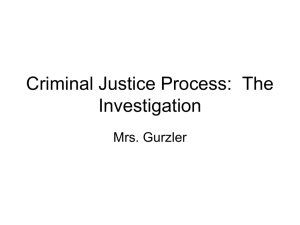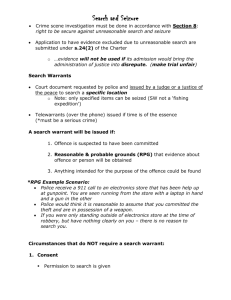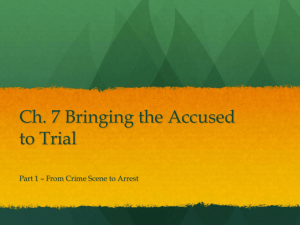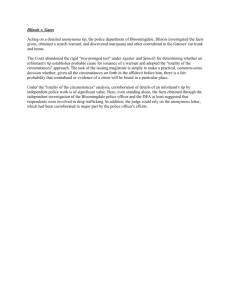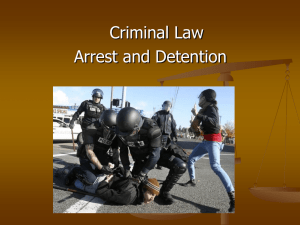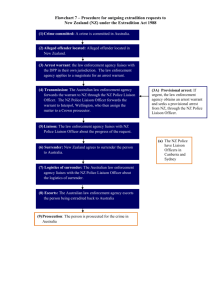Arrest and Detention
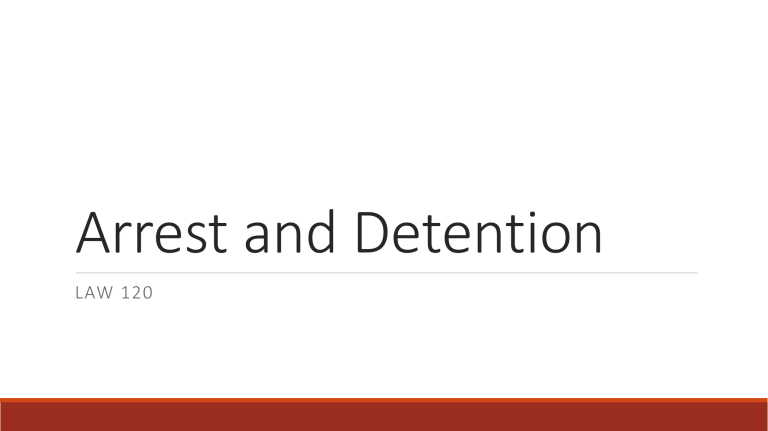
Arrest and Detention
LAW 120
Arrest and Detention
Once the police have collected evidence they will begin to question suspects
Depending on the evidence, questioning can be done before or after an arrest
There are specific rules that must be followed when interrogating suspect. These laws are:
codified in the Criminal Code
Developed through case law
Part of the Charter of Rights and Freedoms
Failure to follow these procedures can result in cases failing apart when evidence/information collected improperly are considered inadmissible.
Questioning - Accused
Police are required to ask questions as they investigate but cannot force a suspect to answer.
Section 7 of the Charter gives a detained or arrested person the right to remain silent.
Police must promptly inform arrested persons the reason for the arrest and of their right to counsel
Arresting officers must give a standard statement:
You have the right to retain and instruct legal counsel without delay. You have the right to telephone any lawyer you wish. You also have the right to free legal advice from a legal aid lawyer. If you are charged with an offence, you can contact Legal Aid Plan for legal assistance. Do you understand? Do you wish to telephone a lawyer now?
Once the person knows their rights, anything they say or put into writing may be used against them in court.
Interrogation
Police interview suspects to get the truth. To do this they will attempt to develop a trusting relationship with the suspect.
At the beginning of the interview the police will ask open-ended non-threatening questions. i.e.
“Tell me what happened.” This is to get the suspect talking and provide a lot of information
Later investigators will asked specific closed questions. i.e. “What time did you leave your house?”
These questions are designed to get specific answers.
Typically the police will use a 4 stage process to interrogate suspects. They want to suspect to describe:
1) The entire incident
2) The period before the offence took place
3) The details of the actual offence
4) The period following the offence
Arrest and Detention Procedures
A criminal case begins when the police formally charge a person with committing an offence.
The police can either arrest or detain the suspect.
A person placed under arrest is deprived of his/her liberty by legal authority. In order for an arrest to be lawful, the arresting officer must follow four steps:
1) Identify him/herself as a police officer
2) Advise the accused that he/she is under arrest.
3) Inform the accused promptly of the charge and show the arrest warrant if one has been obtained.
4) Touch the accused to indicate that he/she is in legal custody. Once in custody the police must informed the accused of the right to counsel.
Arrest and Detention Procedures
In some situations, the police will detain the person
Detention involves stopping someone and asking the individual to answer a few questions.
When the police detain someone they are depriving them of their liberty, with or without physical restraint.
People must be told promptly the reasons for detention and their right to retain counsel.
Police cannot arrest anyone they suspect of committing a crime. They need to have some proof that the crime occurred and reasonable grounds that this person committed that act. A reasonable person test must be applied to the information available.
Responsible citizens usually co-operate with the police. If the questions go beyond an appropriate point, it is best to contact a lawyer. If they are being held or arrest arbitrarily/improperly that person may sue the police for unlawful arrest.
Appearance Notice
Police have 3 methods for apprehending an offender. They can
1) Issue appearance notice
2) Arrest the suspect with a warrant
3) Arrest the suspect without a warrant
For most summary offences and less serious indictable offences police will issue an appearance
notice – a legal document requiring the accused to appear in court on a specific date. Accused must sign the notice and be given a copy.
If the accused does not appear, the police can ask the judge for a bench warrant for the original offence and for ‘failure to appear’.
Arrest with a Warrant
When a person is suspected of committing a serious indictable offence, the police may ask a judge to issue a summons. These are usually issued when it is believed the accused will appear in court of the date required. Suspect usually needs to go to the police station for fingerprinting.
Failure to appear can lead to a bench warrant being issued.
If the police believe the accused will not appear voluntarily, they can obtain an arrest warrant from a judge. The police must provide a sworn information (statement given under oath). Once the police ‘lay an information’, the judge will determine whether or not there is enough to grant the warrant.
An arrest warrant is a written court order directing the police to arrest a suspect. Warrant provides accused’s name, offence being charged with and reason for warrant.
Arrest without a Warrant
Three circumstances when a suspect can be arrest without a warrant.
1) Reasonable grounds to suspect person has or about to commit an indictable offence.
2) Person is found in the act of committing a criminal offence.
3) Person is believed to be named in an existing arrest warrant.
All peace officers are allowed to arrest without a warrant in these cases. Peace officers can be mayors, prison guards, customs officers, aircraft pilots and fisheries officers.
Citizen’s Arrest
Most common form of citizen’s arrest involves incidents of shoplifting. Suspects usually arrested by store detective or salesperson.
Immediately after a citizen’s arrest is made the accused must be turned over to a police officer.
Citizen’s arrests are rare. People are usually concerned about being hurt trying to apprehend a violent suspect or of being sued for wrongful arrest.
Circumstances when a citizen’s arrest can be made without a warrant when:
A person who is committing, believed to have committed or is escaping from lawful authority after committing an indictable offence (reasonable grounds).
If a citizen’s arrest is related to an offence committed on or in relation to property the accused may be arrested by the owner of the property or a person authorized by the owner.
Searches
Law must balance rights to privacy with the need to conduct thorough investigations.
Charter of Rights Section 8 provides from unreasonable search and seizure. Generally the police must obtain a warrant to conduct a search.
Exception to this rule relate to searching a person they have just arrested as long as:
1.
The arrest was lawful
2.
The search must be connected to the lawful arrest.
3.
The manner in which the search was carried out must be reasonable.
Except in cases of impaired driving the accused does not have to give the police breath, blood or urine samples unless the police have a warrant. Even with a warrant accused persons are usually allowed to talk to a lawyer before complying. i.e. DNA in murder cases
Suspects can expect to be ‘patted down’ for weapons before a thorough search or even strip search is conducted at the police station.
Searches
Searching a place requires the police to obtain a warrant.
A search warrant is a court document that allows the police the right to search a specific place on a specific date. If the warrant is improperly obtained or improperly filled out, the court can throw out any evidence obtained by the warrant.
To obtain a warrant the police must swear an information to a judge. The information must include the crime, the items the police are looking for and the reasonable grounds they have for believing the items are in that location.
If the warrant is granted the document will list all the above details as well as the date and time the police are allowed to search. For a residence, the search is usually authorized for one day during daylight hours. Usually warrants are good between 6am and 9pm.
Police must identify themselves and show the warrant to the person living/working there.
During a search the police may take other items not listed on the warrant as long as they are related to the crime and are in plain view. Any objects used as evidence are kept in police custody. All other items must be returned within 3 months.
Searches
When the police must act quickly a telewarrant can be issued. A telewarrant is a search warrant obtained over the phone or by fax.
All the information is given over the phone and the judge files this information with the court. A facsimile warrant is filled out by the officer and shown at the scene of the search.
Search warrants are almost always required to search a private home. Two exceptions allow the police to enter without a warrant. Pressing circumstances make it difficult to receive a warrant in time.
Police believe they must enter to prevent injury or death.
Police believe they must enter to prevent the destruction of evidence related to an indictable offence.
Controlled Drugs and Substances Act allows the police to search any premises except a person’s residence for illegal drugs without obtaining a warrant. Anyone on the premises can also be searched without a warrant if it is believed they are carrying illegal drugs.
Provincial liquor laws allow the police to search motor vehicles for illegal alcohol without a warrant.
Arrest and Detention Assignment
Arrest and Detention p.202-209
R v. Mann #1-4
R v. Buhay #1,2
BYU #4-7
